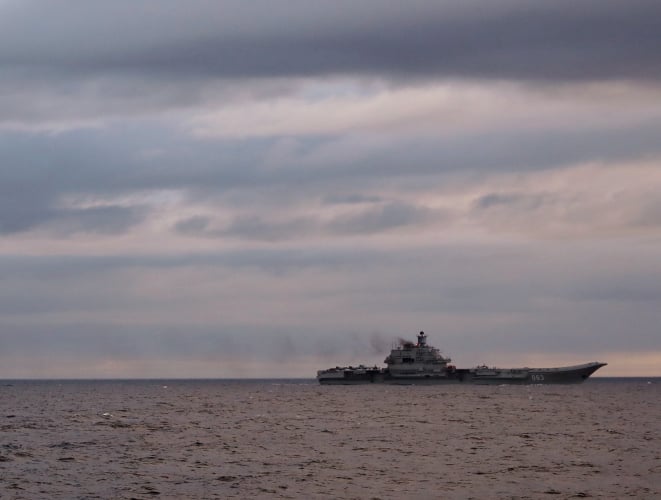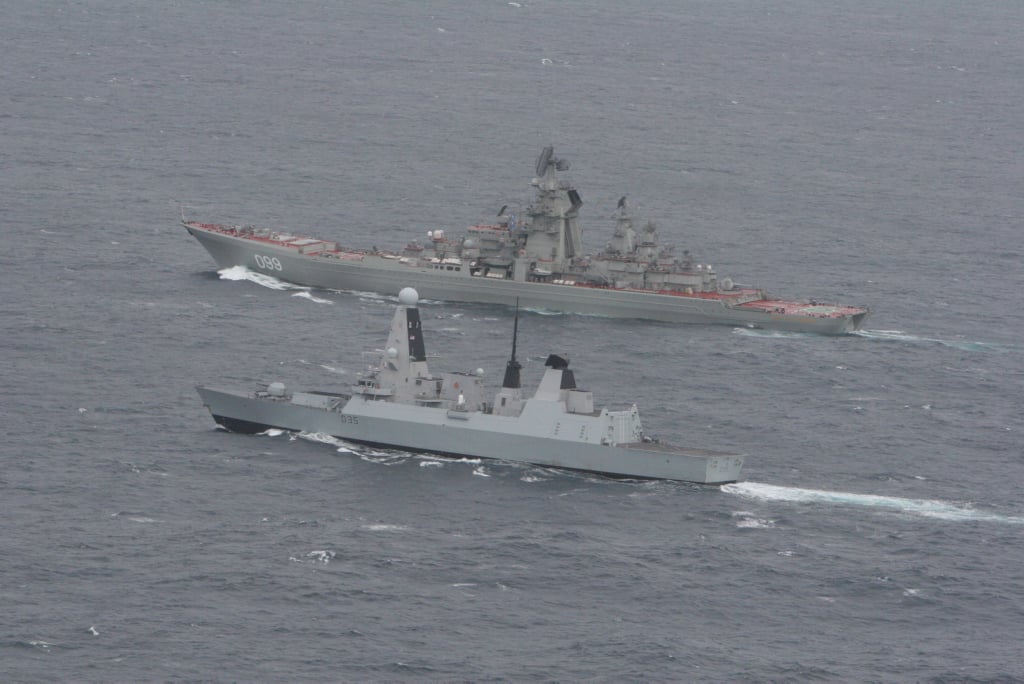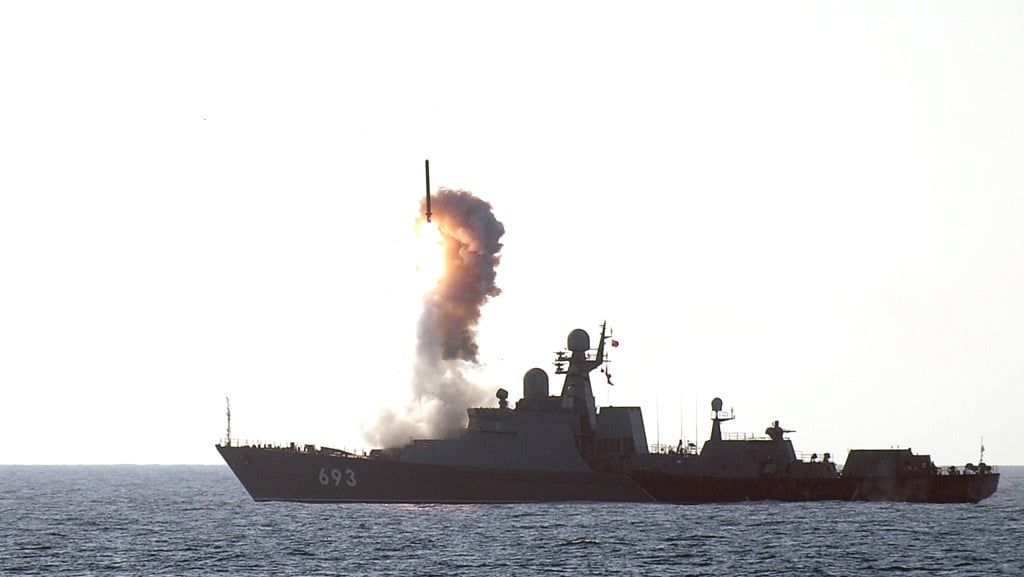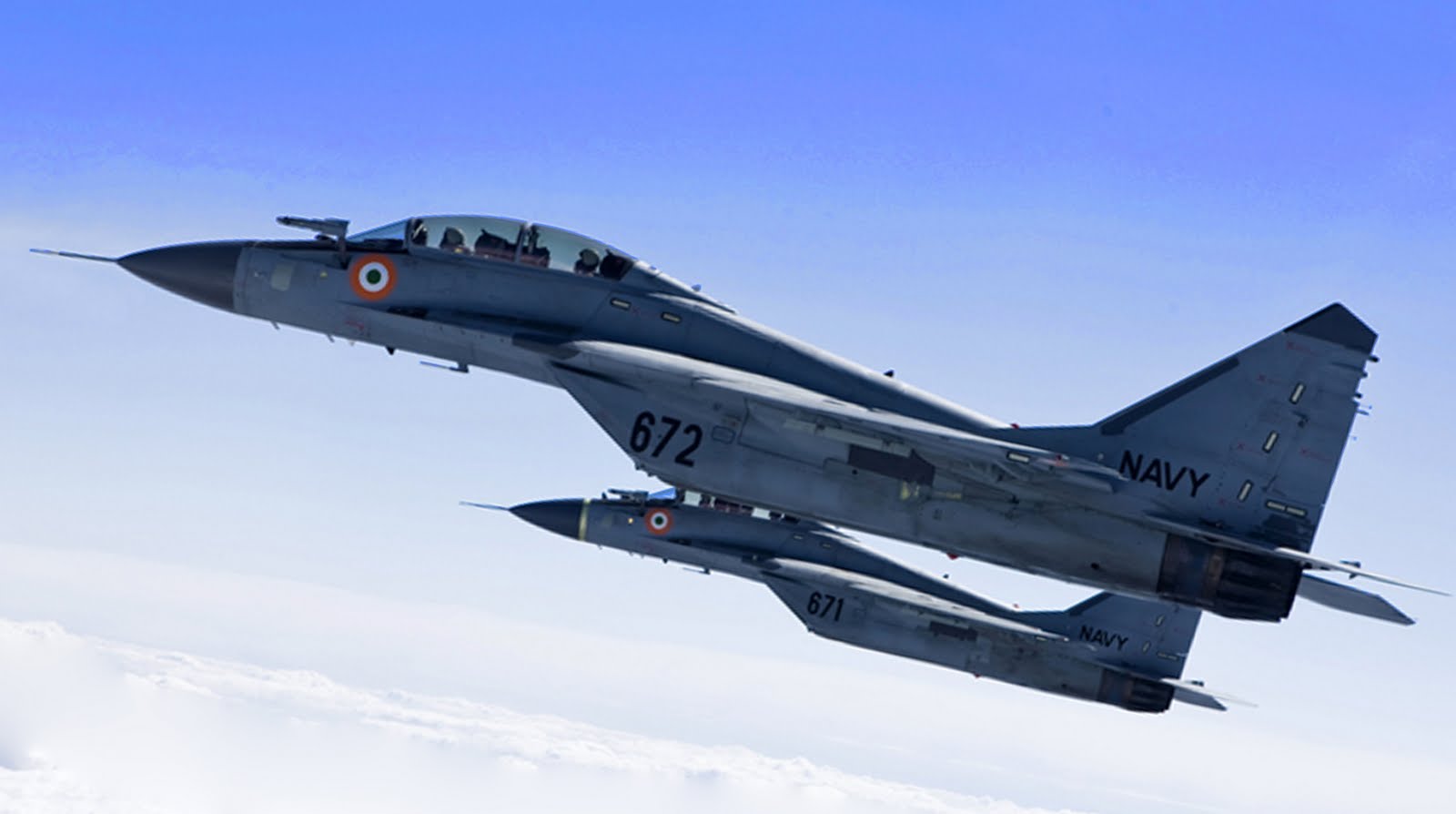
The Russian navy has deployed the core of its Murmansk-based Northern Fleet to the Eastern Mediterranean to participate in the war in Syria.
The flagship of this battle group is the largest of Russia’s warships, the aircraft carrier Admiral Kuznetsov. This battle group, consisting of four warships, currently is steaming around Europe heading to the Eastern Mediterranean, with the conventionally-powered carrier belching smoke all along the way. Why is Russia deploying this fleet to the Eastern Mediterranean?
Russian media outlets have made it quite clear that the Admiral Kuznetsov is headed south to take part in the war in Syria.
As the writer Taylor Marvin has pointed out, the Admiral Kuznetsov was not designed for strike missions, like U.S. carriers—it was designed to be part of the Soviet “bastion” strategy and help protect areas of the ocean close to Soviet shores from Western incursion, particularly by anti-submarine warfare assets. Admiral Kuznetsov does not have catapults to launch aircraft, so the aircraft that take off to bomb targets in Syria can carry fewer and smaller weapons.
Russian journalist Sergei Parkhomenko, speaking to the Russian radio station Echo of Moscow, pooh-poohed the military aspects of the deployment, pointing out that the “antique” carrier is not suited for modern naval warfare, that it is not useful as a second airfield for any aircraft operating out of Russia’s Tartus base in Syria, and that the base in Tartus is so small as to not warrant any additional defense.

However, he said that the Admiral Kuznetsov is working in one key way: an old friend of his in Italy who is an apolitical children’s book illustrator emailed him a photo of the aircraft carrier and asked “What is this?”
This statement points to the main reasons behind this deployment. If there isn’t military purpose of the fleet to be off Syria why are they going there?
Here are some options:
- An ongoing Russian propaganda campaign to emphasize the war in Syria for their own populace (instead of the stalemate in Ukraine) and perhaps even frighten the West.
- A play for relevance in a high-profile war by Russia’s outdated Northern Fleet.
- A marketing opportunity for the Russian defense industry.
First, the propaganda campaign: About a year ago Russian propaganda began heavily emphasizing the Syrian war, in domestic television, over the Ukraine war. That has mostly remained the case since then. The war in Syria emphasizes Putin’s role in fighting terrorism, and his propaganda machine emphasizes that Russia is making real progress against ISIS, unlike the West, and sometimes it even intimates that the West is behind ISIS. Therefore activity in Syria can be spun as part of Putin’s efforts to keep Russia safe from terrorists and Western powers.
The voyage of Admiral Kuznetsov around Europe is an opportunity for Russian propaganda to suggest that the Russian navy still appears threatening to Russia’s “traditional enemies” in the West. Russia Today happily repeated the statement from the British tabloid The Daily Mail that the Royal Navy was on “high alert” as the Russian battle group moved through the English channel. One Russian news outlet suggested that the recent departure of the USS Mount Whitney from the Black Sea was prompted by the voyage of the Admiral Kuznetsov’s battle group to the Eastern Mediterranean.
Even though war drums are beating in the Russian and the Western press, the deployment of the entire operational Northern Fleet to Syria during this time of heightened tensions may demonstrate nothing more than Russian saber-rattling. If Russian strategists really had any belief that they would be at war with the West in the near future, why would they expose their important northern naval flank by sending away their active Northern Fleet from a place where even those outdated ships could be effective to fight in a land far from Russia (not to mention, providing any potential adversary with a giant, nearly indefensible target full of hundreds of Russian sailors and airmen).

Second, moving the Admiral Kuznetsov battlegroup to the Mediterranean is an attempt to highlight the relevance of Russia’s Cold War-era surface fleet. Unlike the Russian fleet’s demonstration of its modern Kalibr cruise missile capabilities during the Russian strikes on Syria in 2015, this deployment is a demonstration of the last remnants of the once-mighty Soviet fleet. Russia’s high command probably no longer believes in the efficacy of Russia’s aging carrier.
The future of the Russian navy is in submarines and small craft carrying advanced long-range missiles, not in the lumbering Admiral Kuznetsov. Submarines and small craft are unobtrusive by design, so while they may be more useful for the future of Russian naval combat, they have limited use for Russian propaganda, and are not great peacetime advertisements for the continued relevance of the Russian navy. Admiral Kuznetsov, for all its faults, does give the Russian navy the opportunity to show the flag, and get the attention of the West. However, there is a risk that the PR stunt could turn into a problem if Admiral Kuznetsov or one of its support ships breaks down.
Admiral Kuznetsov broke down in the Bay of Biscay in 2012 after visiting Syria, and had to be towed thousands of miles back to Russia. The Russian fleet must be confident of its ability to avoid a similar fiasco this year, as the amount of publicity surrounding this deployment would result in a PR disaster for the Russian navy if there was a repeat breakdown.
The group heading to the Mediterranean also includes the nuclear powered battlecruiser Pyoter Velikiy (laid down in 1986), the destroyers Vice-Admiral Kulakov (laid down 1977) and Severomorsk (laid down 1984), and the the tanker Sergei Osipov (laid down 1973). The final member of the group is the tug that got the carrier out of its jam in 2012. This vessel, the Nikolai Chiker, is youngest ship in the group and one of the most powerful tugs in the world, but it was built in Finland for the Soviet navy, not in a Soviet shipyard.

Even while Russia’s carrier program is foundering Russia has invested significant resources in improving and showing off its carrier-based aircraft, particularly the MiG-29K. India has had problems with its naval MiG-29k aircraft, and actually received and began using its MiG-29Ks before the Russian navy. Russia is probably trying to reassure India that its Russian-built carrier aircraft can perform, if India is patient and continues to invest in the program.
The Russian naval deployment of Admiral Kuznetsov may have gotten the attention of the Western press, but it has little military relevance. It is a propaganda ploy that shows of the past of the Soviet navy, not the future of the Russian navy—which is in submarines, cruise missiles, and small, cheap and agile surface combatants.




